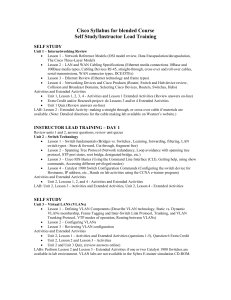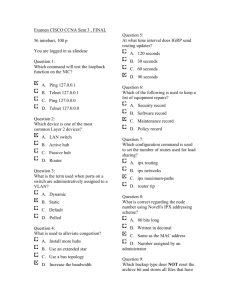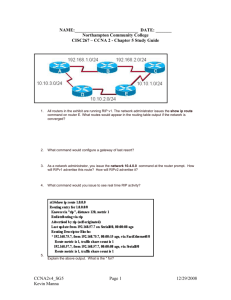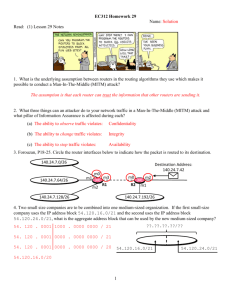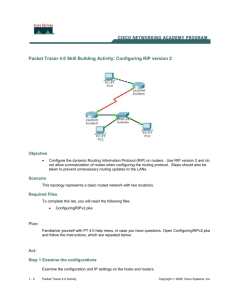I do not believe I addressed my experience with the Cisco
advertisement
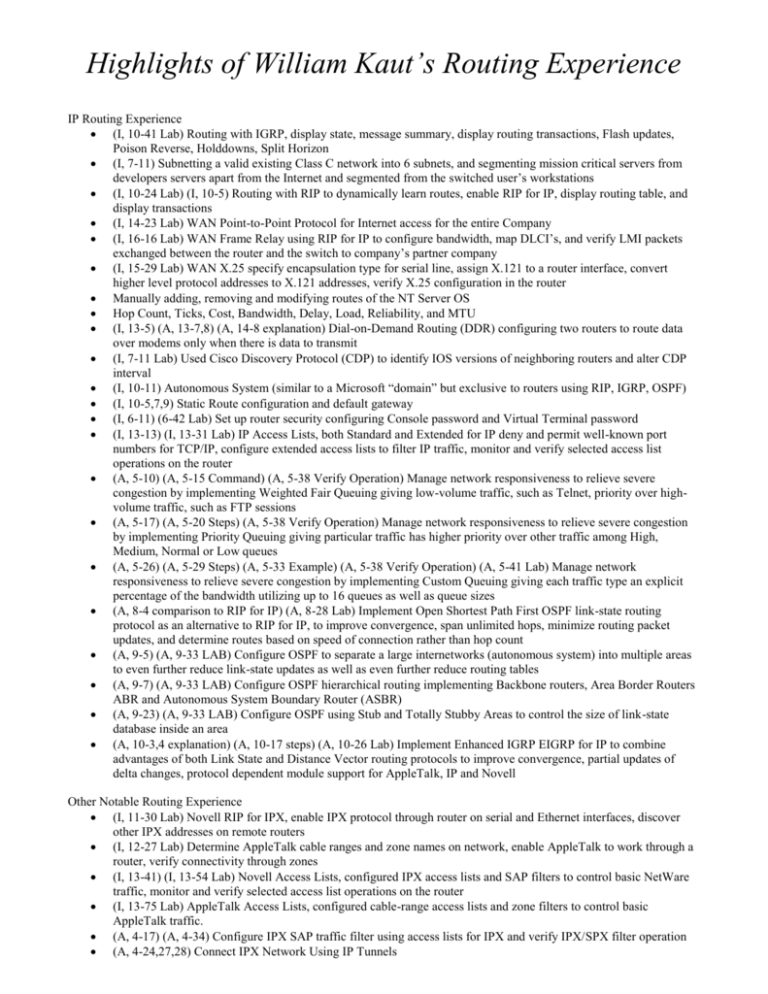
Highlights of William Kaut’s Routing Experience IP Routing Experience (I, 10-41 Lab) Routing with IGRP, display state, message summary, display routing transactions, Flash updates, Poison Reverse, Holddowns, Split Horizon (I, 7-11) Subnetting a valid existing Class C network into 6 subnets, and segmenting mission critical servers from developers servers apart from the Internet and segmented from the switched user’s workstations (I, 10-24 Lab) (I, 10-5) Routing with RIP to dynamically learn routes, enable RIP for IP, display routing table, and display transactions (I, 14-23 Lab) WAN Point-to-Point Protocol for Internet access for the entire Company (I, 16-16 Lab) WAN Frame Relay using RIP for IP to configure bandwidth, map DLCI’s, and verify LMI packets exchanged between the router and the switch to company’s partner company (I, 15-29 Lab) WAN X.25 specify encapsulation type for serial line, assign X.121 to a router interface, convert higher level protocol addresses to X.121 addresses, verify X.25 configuration in the router Manually adding, removing and modifying routes of the NT Server OS Hop Count, Ticks, Cost, Bandwidth, Delay, Load, Reliability, and MTU (I, 13-5) (A, 13-7,8) (A, 14-8 explanation) Dial-on-Demand Routing (DDR) configuring two routers to route data over modems only when there is data to transmit (I, 7-11 Lab) Used Cisco Discovery Protocol (CDP) to identify IOS versions of neighboring routers and alter CDP interval (I, 10-11) Autonomous System (similar to a Microsoft “domain” but exclusive to routers using RIP, IGRP, OSPF) (I, 10-5,7,9) Static Route configuration and default gateway (I, 6-11) (6-42 Lab) Set up router security configuring Console password and Virtual Terminal password (I, 13-13) (I, 13-31 Lab) IP Access Lists, both Standard and Extended for IP deny and permit well-known port numbers for TCP/IP, configure extended access lists to filter IP traffic, monitor and verify selected access list operations on the router (A, 5-10) (A, 5-15 Command) (A, 5-38 Verify Operation) Manage network responsiveness to relieve severe congestion by implementing Weighted Fair Queuing giving low-volume traffic, such as Telnet, priority over highvolume traffic, such as FTP sessions (A, 5-17) (A, 5-20 Steps) (A, 5-38 Verify Operation) Manage network responsiveness to relieve severe congestion by implementing Priority Queuing giving particular traffic has higher priority over other traffic among High, Medium, Normal or Low queues (A, 5-26) (A, 5-29 Steps) (A, 5-33 Example) (A, 5-38 Verify Operation) (A, 5-41 Lab) Manage network responsiveness to relieve severe congestion by implementing Custom Queuing giving each traffic type an explicit percentage of the bandwidth utilizing up to 16 queues as well as queue sizes (A, 8-4 comparison to RIP for IP) (A, 8-28 Lab) Implement Open Shortest Path First OSPF link-state routing protocol as an alternative to RIP for IP, to improve convergence, span unlimited hops, minimize routing packet updates, and determine routes based on speed of connection rather than hop count (A, 9-5) (A, 9-33 LAB) Configure OSPF to separate a large internetworks (autonomous system) into multiple areas to even further reduce link-state updates as well as even further reduce routing tables (A, 9-7) (A, 9-33 LAB) Configure OSPF hierarchical routing implementing Backbone routers, Area Border Routers ABR and Autonomous System Boundary Router (ASBR) (A, 9-23) (A, 9-33 LAB) Configure OSPF using Stub and Totally Stubby Areas to control the size of link-state database inside an area (A, 10-3,4 explanation) (A, 10-17 steps) (A, 10-26 Lab) Implement Enhanced IGRP EIGRP for IP to combine advantages of both Link State and Distance Vector routing protocols to improve convergence, partial updates of delta changes, protocol dependent module support for AppleTalk, IP and Novell Other Notable Routing Experience (I, 11-30 Lab) Novell RIP for IPX, enable IPX protocol through router on serial and Ethernet interfaces, discover other IPX addresses on remote routers (I, 12-27 Lab) Determine AppleTalk cable ranges and zone names on network, enable AppleTalk to work through a router, verify connectivity through zones (I, 13-41) (I, 13-54 Lab) Novell Access Lists, configured IPX access lists and SAP filters to control basic NetWare traffic, monitor and verify selected access list operations on the router (I, 13-75 Lab) AppleTalk Access Lists, configured cable-range access lists and zone filters to control basic AppleTalk traffic. (A, 4-17) (A, 4-34) Configure IPX SAP traffic filter using access lists for IPX and verify IPX/SPX filter operation (A, 4-24,27,28) Connect IPX Network Using IP Tunnels Special Experience Set up a Cisco 3640 without an IOS, upgraded the Flash RAM of a Cisco 3640 router from the ground up, Flash RAM is ROM where the router operating system (IOS) exists. Determined the most compatible and updated version of IOS. Implement TFTP server and transfer Cisco IOS to Flash RAM of the router. Note during the update procedure, since no Cisco IOS was available, only the few ROM monitor mode commands were available, which is a mode of minimal router commands an administrator rarely sees.


